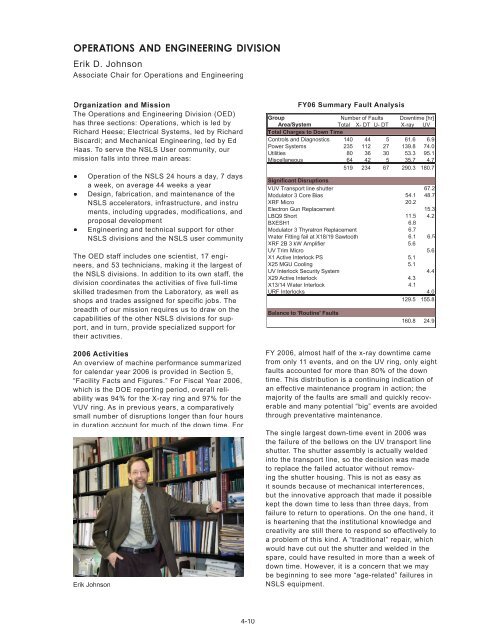NSLS Activity Report 2006 - Brookhaven National Laboratory
NSLS Activity Report 2006 - Brookhaven National Laboratory
NSLS Activity Report 2006 - Brookhaven National Laboratory
Create successful ePaper yourself
Turn your PDF publications into a flip-book with our unique Google optimized e-Paper software.
OPERATIONS AND ENGINEERING DIVISION<br />
Erik D. Johnson<br />
Associate Chair for Operations and Engineering<br />
Organization and Mission<br />
The Operations and Engineering Division (OED)<br />
has three sections: Operations, which is led by<br />
Richard Heese; Electrical Systems, led by Richard<br />
Biscardi; and Mechanical Engineering, led by Ed<br />
Haas. To serve the <strong>NSLS</strong> User community, our<br />
mission falls into three main areas:<br />
● Operation of the <strong>NSLS</strong> 24 hours a day, 7 days<br />
a week, on average 44 weeks a year<br />
● Design, fabrication, and maintenance of the<br />
<strong>NSLS</strong> accelerators, infrastructure, and instru<br />
ments, including upgrades, modifications, and<br />
proposal development<br />
● Engineering and technical support for other<br />
<strong>NSLS</strong> divisions and the <strong>NSLS</strong> user community<br />
The OED staff includes one scientist, 17 engineers,<br />
and 53 technicians, making it the largest of<br />
the <strong>NSLS</strong> divisions. In addition to its own staff, the<br />
division coordinates the activities of five full-time<br />
skilled tradesmen from the <strong>Laboratory</strong>, as well as<br />
shops and trades assigned for specific jobs. The<br />
breadth of our mission requires us to draw on the<br />
capabilities of the other <strong>NSLS</strong> divisions for support,<br />
and in turn, provide specialized support for<br />
their activities.<br />
<strong>2006</strong> Activities<br />
An overview of machine performance summarized<br />
for calendar year <strong>2006</strong> is provided in Section 5,<br />
“Facility Facts and Figures.” For Fiscal Year <strong>2006</strong>,<br />
which is the DOE reporting period, overall reliability<br />
was 94% for the X-ray ring and 97% for the<br />
VUV ring. As in previous years, a comparatively<br />
small number of disruptions longer than four hours<br />
in duration account for much of the down time. For<br />
Erik Johnson<br />
4-10<br />
FY06 Summary Fault Analysis<br />
Group<br />
Number of Faults Downtime [hr]<br />
Area/System Total X- DT U- DT X-ray UV<br />
Total Charges to Down Time<br />
Controls and Diagnostics 140 44 5 61.6 6.9<br />
Power Systems 235 112 27 139.8 74.0<br />
Utilities 80 36 30 53.3 95.1<br />
Miscellaneous 64 42 5 35.7 4.7<br />
519 234 67 290.3 180.7<br />
Significant Disruptions<br />
VUV Transport line shutter 67.2<br />
Modulator 3 Core Bias 54.1 48.7<br />
XRF Micro 20.2<br />
Electron Gun Replacement 15.3<br />
LBQ9 Short 11.5 4.2<br />
BXESH1 6.8<br />
Modulator 3 Thyratron Replacement 6.7<br />
Water Fitting fail at X18/19 Sawtooth 6.1 6.5<br />
XRF 2B 3 kW Amplifier 5.6<br />
UV Trim Micro 5.6<br />
X1 Active Interlock PS 5.1<br />
X25 MGU Cooling 5.1<br />
UV Interlock Security System 4.4<br />
X29 Active Interlock 4.3<br />
X13/14 Water Interlock 4.1<br />
URF Interlocks 4.0<br />
129.5 155.8<br />
Balance to 'Routine' Faults<br />
160.8 24.9<br />
FY <strong>2006</strong>, almost half of the x-ray downtime came<br />
from only 11 events, and on the UV ring, only eight<br />
faults accounted for more than 80% of the down<br />
time. This distribution is a continuing indication of<br />
an effective maintenance program in action; the<br />
majority of the faults are small and quickly recoverable<br />
and many potential “big” events are avoided<br />
through preventative maintenance.<br />
The single largest down-time event in <strong>2006</strong> was<br />
the failure of the bellows on the UV transport line<br />
shutter. The shutter assembly is actually welded<br />
into the transport line, so the decision was made<br />
to replace the failed actuator without removing<br />
the shutter housing. This is not as easy as<br />
it sounds because of mechanical interferences,<br />
but the innovative approach that made it possible<br />
kept the down time to less than three days, from<br />
failure to return to operations. On the one hand, it<br />
is heartening that the institutional knowledge and<br />
creativity are still there to respond so effectively to<br />
a problem of this kind. A “traditional” repair, which<br />
would have cut out the shutter and welded in the<br />
spare, could have resulted in more than a week of<br />
down time. However, it is a concern that we may<br />
be beginning to see more “age-related” failures in<br />
<strong>NSLS</strong> equipment.

















